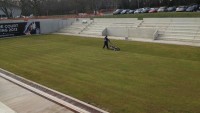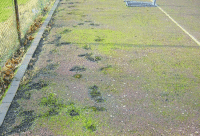Key Tasks for March
General Maintenance

An application of iron sulphate will help kill off any moss; it will usually take a couple of weeks to die, this will enable you to remove the moss during your spring renovation programme - Moss treatments
Ideally, you should conduct a soil analysis to confirm the nutrient status of your soil, and buy an appropriate fertiliser product to suit your requirements - Soil Tests
Get yourself prepared for your spring renovations, which tend to take place towards the back end of March/early April when grass growth is more consistent to aid recovery.
Undertake some aeration work to help get air back into the soil profile.
Mowing frequencies will gradually be more frequent as the grass begins to grow, going from a weekly cut into a 2-3 cuts per week in April. This increased mowing regime helps stimulate the grass plant and help thicken up the sward.
The sward should be maintained at its winter height of cut between 12-18mm. The use of a rotary mower can be ideal for topping off and, at the same time, cleaning up any surface debris.
Usually, these renovation revolve around some light scarification work, which helps remove any dead moss and unwanted thatch, aeration, topdressing and overseeding. Consult the new Grass Seed 2015 booklet to choose appropriate seed cultivars.
A dose of slow release fertiliser can be applied to act as a base feed; this will keep the grass plant fed for a couple of months, which can be supplemented with some liquid feeds as and when required - Fertilisers
If grass shows signs of stress (weak growth, discoloured), fertiliser treatment and turf tonic can be continued in accordance with your annual programme. If you haven't got a fertiliser programme, have your soil tested; try an independent soil analysis company for an impartial set of results. Apply a spring fertiliser when conditions allow.
Moss is generally the main problem at this time of year. Mosses are primitive non-flowering plants that have no root structure and rely on there being sufficient moisture in the environment for reproduction and survival. The majority of mosses are tolerant of acidic conditions and are stimulated by wet humid conditions. Rapid colonisation of moss and algaes usually occur during autumn and winter months when turf surfaces are lying wet and saturated for long periods of time, particularly when little or no aeration has been undertaken.
Remember, moss is the symptom of poor grass growth, and not the cause of it. If you make sure you have a tightly knit sward next year, and have maximised drainage with plenty of regular aeration, you should not have to deal with moss at all.
If you are saddled with a turf situation that has a lot of moss present, there will be a requirement to kill it off. The only product now available to control moss in turf is sulphate of iron (Ferrous Sulphate), it is relatively cheap and effective. It can be applied in a liquid or granular formulation. The granular form is usually mixed with sand to provide a carrier for the active ingredient. Apply at recommended rates.
When using lawn sands, it is important you use a compatible sand product that matches your rootzone soil profile. You do not want to create a layering problem. Some club Groundsmen may not entertain the use of lawn sand, as they do not want to introduce a sand medium into the clay based soil structure.
For tennis courts, I would recommend you apply the sulphate of iron in a liquid form; you will have better control over application rates.
For best results:-
• Apply when the turf is actively growing and the soil is moist
• Mow 3 days before treatment and do not mow for three days after treatment
• Water after 2 days if no rain forecast
• Rake out dead moss thoroughly 7-14 days after treatment
• Re-treatment may be necessary for heavy infestations
Any bare or sparse areas can be lightly tilthed, overseeded and topdressed with a sand/soil rootzone
Daily brushing will help disperse early morning dews and help dry out the sward, thus reducing the amount of surface leaf moisture content that can initiate an outbreak of fungal disease. Brushing also helps stand the sward upright and increase air flow around the grass plant.
It is also important to try and keep the the top 50mm of the soil profile free draining, this is achieved by keeping the surface open to allow gaseous exchange, thus preventing anaerobic conditions prevailing. The surface is kept open by a programme of aeration techniques, varying the type and size of tines used.
With regard to aeration practices, any deep aeration of the courts should have been completed in January, so as not to incur problems later in the year. Deep aeration carried out in late March can lead to the tine holes/slits remaining in the soil profile well into the playing season, which can cause some surface deterioration when the clay soils begin to dry out.
Sarel rollers can still be used to keep the top 20-45mm open to aid surface water drainage.
There may still be some bare or thin sward areas; these can be oversown when weather conditions improve; the use of germination sheets will greatly improve success rates.
Inspect and remove debris from playing surface - litter or any wind blown tree debris, twigs and leaves. Leaf debris can be a problem during the winter months. It is important to sweep and clear the leaves off the courts as an accumulation of wet leaves will damage the grass surface.
Artificial Surfaces

American Fast Dry courts: Keep surface clean, rolling to consolidate surface, levelling and brushing of fast dry materials, brushing to clean lines.
Tarmac Courts: Now is a good time to clean your tarmacadam playing surfaces. Ideally, it pays to power wash the courts surface to remove any debris, moss and algae that will have accumulated and deposited itself on the courts during the winter months. Be careful when washing, using a too powerful washer can result in surface damage.
Keep surfaces clean, regular sweeping and brushing. Repair any hollows or damaged areas. Repaint lines.
Moss and algae can be a serious problem on tarmac tennis courts, especially if the courts are situated next to trees and hedges, the shading and damp conditions create a favourable environment for moss and algae to grow. Regular brushing and cleaning of the courts helps disturb the moss preventing it from taking hold. However, once established, the best methods of control are by a combination of chemical and washing activities. You should use approved chemical products when treating algae problems - Moss and Algae treatment
Clay courts: Keep surface clean, regular sweeping and brushing to restore playing levels using SISIS Trulute or similar equipment. Topdress any hollows or damaged areas. Repaint lines.




At the time of writing, the fast moving current of air which races high above us, known as the jet stream, is sitting lower than would be expected. As a result, the British Isles lie above its path rather than their typical position above. Consequently, this allows cold arctic air to move in from the north and east, bringing with it low temperatures. The meteorologists estimate that this pattern of weather is likely to extend into the middle of March.
Despite all the modern methods we are able to employ to regulate grass plant growth, the one thing we cannot control is the temperature. This means then tricky times for turf managers who would have been hoping for warmer air to raise soil temperatures and, in turn, stimulate recovery growth after the long winter. The good news, of course, is that disease pressure is likely to be low.
Nutrition
Managers across all disciplines will be under pressure when it comes to members and players expectation of Spring. Forcing growth in such conditions, however, is simply not feasible nor sensible. The plant and soil biology know what they need and no amount of fertiliser will force them to respond when they are not ready and warm enough.
The onset of colder weather is, of course, often accompanied by sunshine, which will provide two benefits on areas which receive direct sunlight.
Firstly, photosynthesis and, secondly, localised warming. Plants will use the combination of solar energy and localised warming from the sunlight to produce sugars and start metabolic function. However, the problem with cool air at this time of the year is two fold:
- Warming and photosynthesis happen in short lived concentrated blocks of time.
- Cold night-time temperatures mean the daily base line soil temperature drops as the soil does not build up any warming momentum.
The result is patchy and inconsistent growth. A useful analogy is to think of it rather like a cyclist trying to get up to sprinting speed as quickly as possible, when every tenth rotation of the pedals his foot slips off.
In relation to inputs, it is a time to concentrate on maximising the windows when the plant and soil biology is active, as well as assisting the plant to withstand desiccation and drought from cold winds. The means to do that is with little and often liquid or soluble applications aimed at the leaf, with the intention of maximising rapid uptake and assimilation. Tools to achieve in this outcome are:
Nitrate nitrogen – research shows it is absorbed into the leaf over 48 hours where it then resides in the spaces between cells ready and waiting to be assimilated when the plant requests it.
Humic Substances – in particular, micronised formulations containing a percentage of Fulvic Acid which acts to pull fertilisers into the plant more efficiently.
Carbon – the foundation energy source of plant and soil life; providing carbon increases utilisation efficiency of fertilisers and props up the soil food web.
Seaweed – plant stress hormones prime the plant by eliciting metabolic functions which allow it to better withstand environmental (abiotic) and pathogenic (biotic) stress.
Calcium – strengthens cell walls, creating a more resilient plant.
Micro nutrients – anyone looking to make informed decisions on their soil health will have had a full chemical analysis undertaken. Foliar applications of deficient nutrients in the tank mix will allow you to overcome a lack of supply of the soil, and provide the plant with everything it needs to maximise those concentrated blocks of light energy and warmth.
Two other important factors with regards to nutrition in a cold dry spring are:
Patience – understand what the plant needs and when; don’t be tempted to plough in nutrient that cannot be consumed. It will either leach into water courses or sit, slowly degrading, forcing a disease susceptible and mower demanding flush when conditions turn warm and wet.
Preparation – get a conventional release Ammonium sulphate based granular fertiliser on the shelf, ready to go down as soon as you see and hear the forecasters confidently predicting a consistent upturn in temperatures and available moisture. Preferably one containing a little calcium for cell division and magnesium for chlorophyll production.
Moss
March is an excellent time to treat moss; however, beware too much sulphate of iron if desiccating winds are prevalent, and most certainly hold back scarifying until strong consistent grass growth is there to repair the sward.
Aeration
As areas dry out from the winter, getting on the ground with machinery and aerating will be possible. Little and often in multiple different ways is a good mantra, but beware desiccating winds leading to too much drying of the surface; especially on poa annua dominated swards
Surfactants
March is the time to start applying polymer wetting agents, such that you have enough time for the chemistry to build up in the soil ahead of summer. Prevention is absolutely better than cure when it comes to dry patch, and planning and preparation now prevents poor surfaces later in the year.
Fairy rings
March is a good time to prevent the effects from type two fair rings in the summer. A combination of aeration, surfactants and azoxystrobin fungicide will allow water and active ingredient to move into hydrophobic regions occupied by the fungal mycelium.
You should have had your mower serviced and sharpened ready for the new season..
Keep machines overhauled and clean.
Inspect and repair any watering or irrigation systems; many bowling clubs now have pop-up irrigation systems, so ensure they have been drained down for winter. Organise an inspection, re-commissioning and calibration of the system.

Some of the courses available are:
- Chainsaws - CS30 and CS31
- H&S Refresher Training on Combined Turf Care Equipment; Tractors and Trailers; All Mowers (Ride-on and Pedestrian)
- Machinery Courses on ATVs; Tractors: Brushcutters/Strimmers; Mowers (ride-on and Pedestrian)
- Pesticide Application (PA courses)
- Stem Injection of Invasive Species (Japanese Knotweed etc.)
- Basic Trees Survey and Inspection
More details about all the courses can be found on our Grounds Training website, or you can email Carol Smith for information.
Tennis structures: Inspect stored posts, nets, seating and notice/score boards. Replace with new equipment if required. Repair any damaged fencing.
Litter: Inspect and remove debris from playing surface - litter or any wind blown tree debris, twigs and leaves. It is important to sweep and clear the leaves off the courts as an accumulation of wet leaves will damage the grass surface.


